[Featured] Environmental Science & Engineering Magazine: June 2017
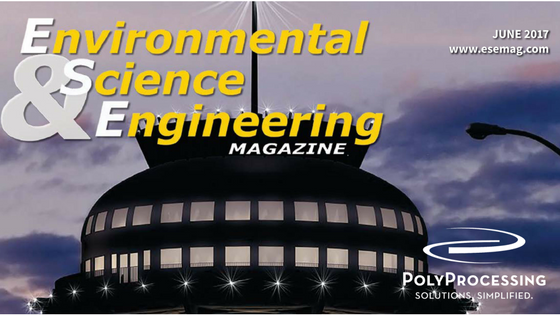
When it comes to providing you with the newest innovations in polyethylene chemical storage tanks, Poly Processing stays ahead of the curve. From linear polyethylene parts and cross-linked polyethylene to full drainage systems and tank fittings - we’ve uncovered everything you need to know to safely store chemicals in our article featured in Environmental Science & Engineering Magazine’s June publication. Our marketing team is sharing these insights and more in today’s blog, but you can also access the article on pages 40 to 42 by browsing here.
- An effective way to contain a spill or leak is a secondary containment system called a double wall tank, “tank-within-a-tank,” or a SAFE-Tank.
- When storing an oxidizing chemical in a polyethylene tank, an antioxidant barrier provides added tank longevity.
- Selecting the right tank fittings for chemical storage is crucial to ensure optimum function, safeguard personnel safety and to maximize the life of the polyethylene tank.
8 Critical Innovations in Polyethylene Chemical Storage Tanks
At a glance, it’s impossible to gauge the life of your chemical storage tank, there are many things to know and consider that will help you extend the life of your tank to its fullest potential. It is important to know that from the production of the raw materials through installation, it is expertly manufactured with all of the right gaskets and fittings.
The goal of this article is to update the reader with the latest in material technology. We will discuss new engineered polyethylene tank resins, innovative tank configurations, and engineered fittings.
New Engineered Resins for Chemical Storage
High-density polyethylene chemical storage tanks can be made of linear polyethylene or cross-linked polyethylene. They are both made with resins that are heated to create a hollow plastic part, yet the differences in their development create very different polyethylenes of structural strength.
Linear Polyethylene
Linear polyethylene parts are created when thermoplastic resin pellets are ground and then heated to create the fluid plastic that will harden and cure into a linear, high-density polyethylene surface. Envision a rope where the individual threads of fiber are twisted together, but not tied. The result is a linear resin that has polymer chains “tangled” together, rather than tied. Linear polyethylene is cost-efficient, and is safe for storage of benign and non-corrosive chemicals.
Cross-Linked Polyethylene
Cross-linked polyethylene (XLPE) is high-density polyethylene that is manufactured by adding a catalyst to the thermoplastic resin which turns it into a thermoset. The catalyst causes a covalent bond that links the molecules together. Picture a chain linked fence where the metal is actually linked together. The result is a plastic that possesses impact, tensile strength and resistance to fracture which makes cross-linked polyethylene an excellent choice for chemical storage applications when tank integrity is of utmost importance. The chemical resistance, heat resistance, and dimensional stability is unparalleled.
Because cross-linked polyethylene offers longer tank life and more protection in the long run, there is a little more upfront investment. Cross-linked polyethylene offers 20 times the environmental stress crack resistance of high-density linear polyethylene, has 10 times the molecular weight and greater impact and tensile strength as well. Another difference comes in testing the two plastics. When linear polyethylene fails, it fails catastrophically, because the linear polymer chains “unzip.” Cross-linked polyethylene might develop a small tear or pinhole but cannot catastrophically fail due to the covalent bonds that connect the polymers together. Poly Processing is a leader in the design and manufacturing of crosslinked polyethylene tanks.
Oxidation Resistant Resins
If you’re storing an oxidizing chemical like sulfuric acid or sodium hypochlorite in a polyethylene tank, an antioxidant barrier will give you much greater life of the tank. Polyethylene, whether it be linear or cross-linked, has excellent chemical compatibility compared to other choices. An antioxidant barrier is all about extending the life expectancy of normal polyethylene.
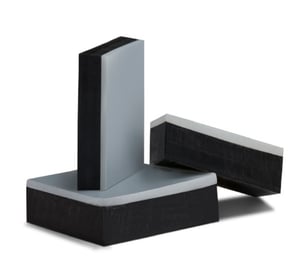 The term “oxidation” originated from the interaction between oxygen molecules and all the different substances they may contact. With the discovery of electrons, oxidation came to be more precisely defined as the loss of at least one electron when two or more substances interact. It doesn’t have to specifically involve oxygen. Free radicals are atoms or groups of atoms with an odd (unpaired) number of electrons and they can easily have their electrons stolen (or oxidized). The carbon atom in all forms of polyethylene is such a group. True oxidation happens on a molecular level. In fact, we only see the large-scale effects when a scavenger causes free radicals on the surface to break away.
The term “oxidation” originated from the interaction between oxygen molecules and all the different substances they may contact. With the discovery of electrons, oxidation came to be more precisely defined as the loss of at least one electron when two or more substances interact. It doesn’t have to specifically involve oxygen. Free radicals are atoms or groups of atoms with an odd (unpaired) number of electrons and they can easily have their electrons stolen (or oxidized). The carbon atom in all forms of polyethylene is such a group. True oxidation happens on a molecular level. In fact, we only see the large-scale effects when a scavenger causes free radicals on the surface to break away.
Antioxidants are additives to the polyethylene; molecules which can safely interact with free radicals and terminate the chain reaction they cause before more vital ethylene molecules are damaged. Antioxidants exist, for example, as enzyme systems within the human body, where they scavenge free radicals. Likewise, vitamin C is an antioxidant in the same way. They simply interact with free radicals and stop the stealing of electrons.
Antioxidant resins contain saturated amounts of antioxidants. Most polyethylene resin already contains some antioxidant to start with. Resin producers intend to protect the plastic resin itself from heat created in the molding process. It is spent during the heating process and non-existent at the completion of the molded part. Having performed the task it was charged with (protecting the plastic during production); it is no longer available for any post-production purpose.
The presence of antioxidant resin in a completed storage tank, however, addresses the chemical resistance of oxidizing chemicals for 15-20 years after the tank ships. Poly Processing Company has developed the OR-1000 antioxidant system and is the world’s leader in rotational molding of antioxidant materials for chemical storage.
Innovative Tank Configurations
There are several different polyethylene tank configurations available in the marketplace today. The leading rotational molding tank companies have innovated over the past few years to develop “state of the art” technology in tank performance, safety, and ease of use. Two of the innovative tank configurations are full drain tanks and double wall tanks. Let’s take a look at each one to determine what design works best for the end user.
Full Drain Tank Systems
One of the biggest challenges in vertical tank design is maintaining the tank’s integrity while still allowing for the tank to be fully drained, cleaned, and properly maintained. Some companies create tanks out of one substance and insert or mold a flange, post-production or during production, for drainage. This works fine, to a point, but there are other alternatives such as an IMFO (Integrally Molded Flanged Outlet).
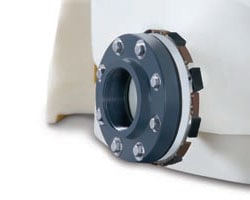 An inserted flange is common in the chemical tank industry, but there are decided benefits to a molded full drain. The main differences lie in impact on the structure and structural integrity, net positive suction possible, and the draining capabilities of the tanks.
An inserted flange is common in the chemical tank industry, but there are decided benefits to a molded full drain. The main differences lie in impact on the structure and structural integrity, net positive suction possible, and the draining capabilities of the tanks.
One-piece construction enhances long-term integrity, both for the tank as a whole and in the knuckle radius, which is the point where the floor of the tank meets its sidewall. The knuckle radius is the thickest part of the tank; so adding an insert post-production or during construction can compromise the tank. An insert can impact the tank's hoop integrity as well, which puts the entire tank at risk of structural stress from volatile chemicals. When the insert is made of metals or alloys, you can run into a whole new set of problems. Chemical reactions in the place where the tank material meets the metal or alloy of an insert can create a stress point for the plastic itself. This can cause leaks or cracks over time.
With an IMFO® system, the drainage flange is molded while the tank is processing, making it a one-piece, stress- free integrated part of the tank. The flange is created using the same material as the tank cross-linked high density polyethylene. It’s not an insert “added on” during or after tank production. An Integrally Molded Flanged Outlet has several key advantages:
- Flange located at the bottom of the tank - permits full tank drainage since outlet is below the tank knuckle radius. This eliminates the need to enter the tank for cleaning.
- One-piece construction enhances long-term performance of the tank, since it doesn’t compromise the tanks hoop integrity or structural design.
- Complete flange face protection available- in aggressive oxidation environments, the antioxidant resin system can protect the drainage components from deterioration.
- Highest amount of static head pressure - the IMFO’s® design brings you the highest net positive
Poly Processing has developed the IMFO® system on tanks from 200 gallons to 13,650 gallons.
Double Wall Tanks
Safe operation and minimizing the risk and hazards associated with spills and leaks is vital in storage of chemicals. An effective way to contain the spill or leak is a secondary containment system called a double wall tank, or "tank-within-a-tank." We'll explore the advantages of a secondary storage tank containment system in this article.
A properly designed "tank-within-a-tank" system keeps contaminants, such as debris and rainwater, from entering the interstitial area. These tanks provide secondary containment to avoid damaging equipment or property, loss of chemical, or injury to employees in the event of a spill. This design provides a leveraged investment that offers peace of mind and environmental care.
Advantages of the properly engineered double wall tank system:
- Provides 110% secondary containment.
- Will equalize the liquid and allow the chemical to be used until it is convenient to inspect and repair the tank.
- Is ideal for chemicals like sulfuric acid that can have dangerous exothermic reactions to water.
- The expense, cost and maintenance of secondary concrete containment is eliminated.
- The footprint of the containment system is minimized. Secondary containment is achieved in a more compact way.
- Addition of a transition fitting maximizes the double wall tank system's performance.
Poly Processing Company is an innovator in double wall tank designs. They have developed the SAFE-Tank systems from 55 Gallons to 8700 Gallons.
Engineered Fittings
Selecting the right fittings for a polyethylene chemical storage tank is crucial. The proper fittings ensure optimum function, personnel safety, and maximum life of the polyethylene tank. Proper sidewall fittings avoid tank leaks and spills. Selecting sidewall fittings purely based on cost can lead to an expensive mistake. Let’s explore two engineered options that will give the end user a peace of mind knowing that chemical compatibility and environmental safety is handled.
Double Wall Fittings
The outlet on a double wall tank becomes the most vulnerable and most commonly used component for wear, but with the way some tank manufacturers address the need, they end up compromising the containment itself. A cost savings technique employed by a few is to use a rubberized doughnut between the inner and outer tank, which bridges the two tanks together. The challenge with this compromise is it reduces flex which the tank needs, but greatly compromises true secondary containment. The pressure that the bottom of the tank experiences in combination with an inflexible fitting creates a hinge point, which commonly fails from wear and leads to compete siphoning of the tank outside of the containment to the outside ground. This creates a dangerous environment, which can result in a workplace.
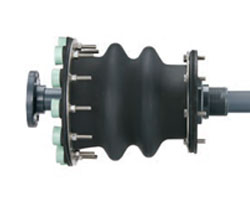 To minimize these threats, Poly Processing offers the bellows transition fitting - with a flexible expansion joint that protects one tank wall from the other against hinge and flex lock. A fitting is attached to the inner tank, while a flexible expansion joint allows the inner tank to expand and contract. The piping is fully contained by this fitting, meaning that there is no hinge point, and the fitting is able to fully contain any leaks that may take place. The bellows transition fitting solves the problems presented by any sleeve-fitting system available. When storing chemicals, you can never be too careful.
To minimize these threats, Poly Processing offers the bellows transition fitting - with a flexible expansion joint that protects one tank wall from the other against hinge and flex lock. A fitting is attached to the inner tank, while a flexible expansion joint allows the inner tank to expand and contract. The piping is fully contained by this fitting, meaning that there is no hinge point, and the fitting is able to fully contain any leaks that may take place. The bellows transition fitting solves the problems presented by any sleeve-fitting system available. When storing chemicals, you can never be too careful.
Adding the enhanced bellows transition fitting will maximize your double wall tank system's performance by allowing you to safely drain the primary tank through single or double-wall piping.
- The double-wall tank can be double-wall piped from the tank to wherever you want the pipe to terminate using a true double wall transition fitting.
- This important fitting drains the primary tank through the containment tank while acting as a secondary containment around the fitting.
- A six-inch flange can be mounted to the outside of a transition fitting and double-wall piping can be run while keeping everything fully contained.
- In most cases, a leak detector in the containment tank as well as the pump containment, are used to insure there are no issues with the pipe throughout the system. These sensors can actuate shutoff valves when they determine that a leak has occurred. This brings a peace of mind and safety to the operator and owner of the tank system or tank farm.
Plastic Encapsulated Bulkhead Fittings
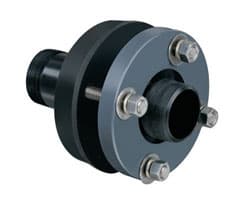 A Bolted One Piece Sure Seal fitting or B.O.S.S.® style fitting is a streamlined one-piece fitting without separate bolts. The fitting connects to the tank with a single gasket to greatly minimize the potential for leaks. A ring with welded studs, available in stainless steel, titanium or alloy C-276 is injection molded with polyethylene around it providing a one piece fitting with a single sealing point. This is the fitting of choice for high profile applications like Sodium Hypochlorite and Sulfuric Acid. Poly Processing Company has developed a B.O.S.S.® fitting and can install it on almost any tank in any location needed.
A Bolted One Piece Sure Seal fitting or B.O.S.S.® style fitting is a streamlined one-piece fitting without separate bolts. The fitting connects to the tank with a single gasket to greatly minimize the potential for leaks. A ring with welded studs, available in stainless steel, titanium or alloy C-276 is injection molded with polyethylene around it providing a one piece fitting with a single sealing point. This is the fitting of choice for high profile applications like Sodium Hypochlorite and Sulfuric Acid. Poly Processing Company has developed a B.O.S.S.® fitting and can install it on almost any tank in any location needed.
Explore the magazine for yourself today. Click the banner to open the June 2017 issue of Environment Science & Engineering.
- July 6, 2017
About Poly Processing
Posts By Topic
Tech Talk Podcast Episodes
Subscribe By Email
Recent Posts
- Protect Your Facility and Your Bottom Line with a Chemical Leak Detection System
- PPC Installation, Operation, and Maintenance Manual: Ensure Tank Longevity
- How To Use The Chemical Resistance Guide
- Better and Safer Alternatives to Downpipes
- Crosslinked Polyethylene Vs. Fiberglass Reinforced Plastic Tanks
Tank Configurator

Find the recommended tank and system components for your chemical storage challenge.
Configure a Tank Package


